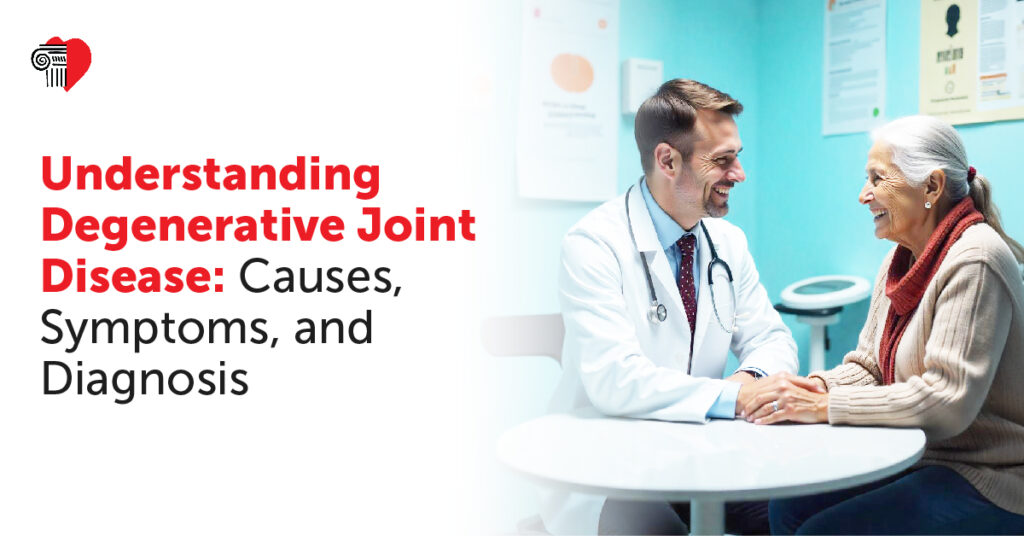Understanding Degenerative Joint Disease: Causes, Symptoms, and Diagnosis
Understanding Degenerative Joint Disease: Causes, Symptoms, and Diagnosis Degenerative joint disease (DJD), most commonly known as osteoarthritis, is a chronic condition that affects millions of people worldwide. As the most prevalent form of arthritis, it primarily involves the gradual breakdown of cartilage—the flexible tissue that cushions joints—leading to pain, stiffness, and limited movement. This disease can significantly impact a person’s quality of life, particularly in older adults, as it is most common with aging. In this blog, we will explore the causes, symptoms, and methods for diagnosing degenerative joint disease, providing a deeper understanding of this debilitating condition. Who can be affected by Degenerative Joint Disease? Degenerative Joint Disease or Osteoarthritis affects about 27 million Americans, with the risk increasing as people age. Most individuals over 60 have some form of the condition, though the severity can vary greatly. While this disease is more common in older adults, younger individuals in their 20s and 30s can also be affected by it. Generally, women over the age of 50 are more likely to experience osteoarthritis than men. What Causes Degenerative Joint Disease? The exact cause of degenerative joint disease is not fully understood, but it is believed to result from a combination of genetic, mechanical, and environmental factors. Several risk factors contribute to the development and progression of Degenerative Joint Disease, including: 1. Age The most significant risk factor for the disease is age. The wear and tear on joints increases with time, making older adults more prone to cartilage breakdown. By the age of 65, a large portion of the population shows some evidence of osteoarthritis, whether symptomatic or not. 2. Genetics Heredity plays a role in DJD. If you have family members with osteoarthritis, you may be more likely to develop the condition yourself. Specific genetic markers have been associated with a predisposition to cartilage damage and joint deterioration. 3. Joint Injury Past injuries, such as fractures or ligament tears, can contribute to the early onset of degenerative joint disease. For example, athletes who suffer repeated trauma to their knees or ankles may develop DJD earlier in life due to accelerated wear and tear on their joints. 4. Obesity Excess weight puts additional stress on weight-bearing joints, such as the knees, hips, and spine. Over time, this extra pressure can cause faster cartilage breakdown and increase the likelihood of developing DJD. Obesity is also linked to inflammation, which can further contribute to joint damage. 5. Occupation and Repetitive Stress Certain jobs or activities that require repetitive motion, heavy lifting, or prolonged standing can lead to joint overuse. People whose work involves repetitive kneeling, bending, or heavy manual labor are more susceptible to the disease, especially in the knees and spine. 6. Bone and Joint Disorders Pre-existing conditions like rheumatoid arthritis, gout, or bone deformities can increase the risk of developing the disease. Joint malalignment or improper movement patterns may cause uneven stress on the cartilage, speeding up degeneration. Symptoms of Degenerative Joint Disease Degenerative joint disease is a progressive condition, meaning that symptoms usually develop gradually and worsen over time. While each individual’s experience may vary, some common symptoms include: Joint discomfort and soreness, especially during movement, is a common symptom. Pain or stiffness can also occur after overuse or long periods of inactivity. Bony growths may develop in the finger joints, particularly in the middle or end joints, which can sometimes be painful. Degenerative joint disease or Osteoarthritis does not typically cause symptoms like fever, weight loss, or anemia (low red blood cell count). If these issues occur in someone with Degenerative Joint Disease, they are likely due to another underlying condition unrelated to the disease itself. Diagnosis of Degenerative Joint Disease Early diagnosis of degenerative joint disease is key to managing symptoms and slowing its progression. Healthcare providers use several approaches to diagnose the disease, including medical history, physical examination, imaging tests, and sometimes laboratory tests. 1. Medical History The first step in diagnosing DJD involves a thorough review of the patient’s medical history. Doctors will inquire about the onset and progression of symptoms, previous injuries, family history of arthritis, and lifestyle factors such as occupation and physical activity levels. 2. Physical Examination During a physical exam, the doctor will assess the affected joint(s) for signs of tenderness, swelling, stiffness, and limited range of motion. They may also listen for crepitus and feel for joint deformities or enlargement. The physical examination can help identify the severity and specific location of joint damage. 3. Imaging Tests Imaging plays a crucial role in confirming a diagnosis of the disease. Commonly used imaging tests include: X-rays: X-rays are often the first imaging test ordered to evaluate joint damage. They can reveal the narrowing of the joint space, the presence of bone spurs, and changes in bone structure that indicate cartilage loss. MRI (Magnetic Resonance Imaging): In some cases, an MRI may be recommended to provide a more detailed view of the soft tissues surrounding the joint, including cartilage, ligaments, and tendons. This can be useful in detecting early cartilage damage that may not be visible on an X-ray. Conclusion Degenerative Joint Disease or Osteoarthritis is a complex condition that can greatly impact a person’s mobility and quality of life. Understanding its causes and symptoms is essential for early detection and effective treatment. With prompt diagnosis, lifestyle changes, medical interventions, and physical therapy, many individuals with DJD can maintain joint function and improve their quality of life. By staying informed and proactive, we can better manage this condition. For expert care and comprehensive treatment options, visit Athens Heart Center & Specialty Clinic.
Understanding Degenerative Joint Disease: Causes, Symptoms, and Diagnosis Read More »


